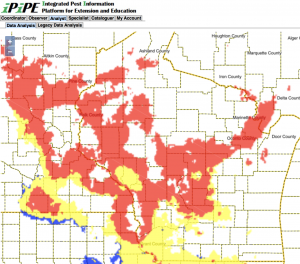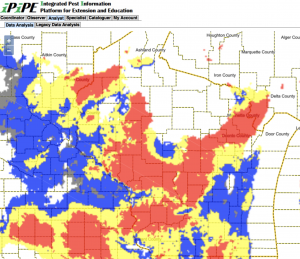Wisconsin White Mold Risk Maps – July 4, 2017
Damon L. Smith, Extension Field Crops Pathologist, University of Wisconsin-Madison
Jaime Willbur, Graduate Research Assistant, University of Wisconsin-Madison
Sclero-cast: A Soybean White Mold Prediction Model
**This tool is for guidance only and should be used with other sources of information and professional advice when determining risk of white mold development. We encourage you to read the model how-to guide which can be downloaded by clicking here**
Risk of apothecial presence and subsequent white mold development has increased very slightly since the last posting. Currently, risk is highest for soybean fields in the west-central to northwest portions of Wisconsin. Risk is also high in a band stretching from south-central Wisconsin to northeast Wisconsin. Risk is further elevated in fields planted to 15″ row-spacing and/or irrigated. Early-planted soybean fields are likely beginning to flowering, these risk models should be monitored frequently to assist in making in-season fungicide application decisions during the soybean bloom period. For more information on white mold and white mold management, see this previous post.
These models were developed at the University of Wisconsin-Madison in conjunction with Michigan State University and Iowa State University to identify at-risk regions which have been experiencing weather favorable for the development of white mold fungus apothecia. Weather information and maps are provided by the Soybean Integrated Pest Information Platform for Extension and Education (iPIPE), which is managed by ZedX, Inc. This model predicts when apothecia will be present in the field using combinations of 30-day averages of maximum temperature, relative humidity, and maximum wind speed. Using virtually available weather data, predictions can be made in most soybean growing regions. Based on these predictions, a map is generated under three scenarios (non-irrigated soybeans, soybeans planted on 15″ row-spacing and irrigated, or soybeans planted on 30″ row-spacing and irrigated). The maps are colored to show the likelihood of apothecial presence within a region. White areas indicate the model is inactive and risk of apothecia in the field is likely low. Gray areas indicate that apothecia might be present, but likelihood of apothecial presence is less than 5%. Blue indicates a low risk (5 to <15% chance), yellow a moderate risk (15 to <30% chance), and red areas indicate a high risk (30% or higher chance). Model predictions must be combined with soybean growth stage and canopy characteristics to aid in timing of fungicide sprays. If the model is predicting high risk (red) in your area for your planting scenario, the soybeans are flowering, and the canopy is somewhat closed, then the white mold risk is elevated. If your fields are at-risk, we recommend to consult your local extension personnel or resources for the best in-season management options for your area For further information on how to use and interpret these risk maps, CLICK HERE to download a how-to guide.





